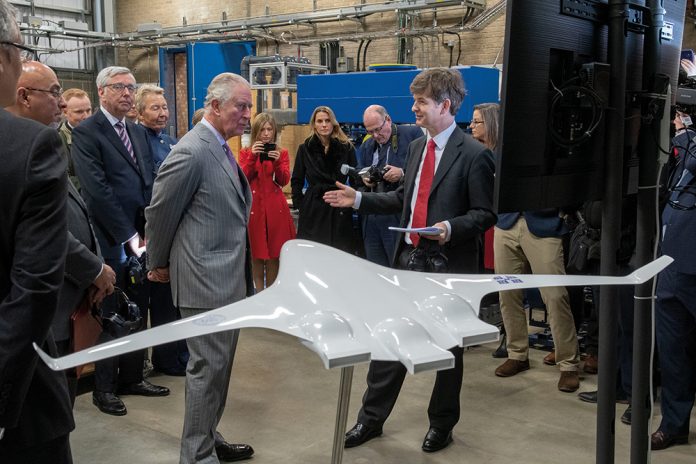The new National Centre for Propulsion and Power was officially launched by the Prince of Wales in January. Now Cambridge City Council’s planning committee has approved plans for the expansion of Cambridge University’s renowned Whittle Laboratory in order to accommodate the ground-breaking enterprise.
Time is of the essence, said the man at the helm of the new centre tasked with accelerating the development of low-carbon technologies for the propulsion and power industries.
Prof. Rob Miller, Director of the Whittle Laboratory, located within the university’s engineering department, said: “Our enemy is time. To achieve net-zero by 2050 we have focused on accelerating the technology development process itself.”
To that end, the new centre, which is due to open in 2022, will bring together researchers from across the UK university network with industry partners such as Rolls Royce, Mitsubishi Heavy Industries, Siemens and Dyson.
Prince Charles started the ball rolling in January. Patron of the University of Cambridge Institute for Sustainability Leadership (CISL), he hosted a roundtable meeting of aviation and power generation business leaders, senior Government officials and researchers.
They talked about how, practically, the UK could accelerate the development of low-carbon technologies.
Prof. Miller said all concerned recognised where we stood in the journey. “We are at a pivotal moment, in terms of both Cambridge’s history of leading technology development in propulsion and power, and humanity’s need to decarbonise these sectors.
“Fifty years ago, the Whittle Laboratory and its industrial partners faced the challenge of making air travel efficient and reliable.
“Now the new Whittle Laboratory and the National Centre will enable us to lead the way in making it green.”
Supported by the Aerospace Technology Institute with funding from the Department of Business, Energy & Industrial Strategy, the centre aims to meet around 80% of the UK’s future aerodynamic technology needs.
Tightening the circle between design, manufacture and testing will be crucial.
In a three-pronged attack, design times are being reduced through the use of artificial intelligence and augmented design systems run on graphics processors, originally developed for computer gaming.
Manufacturing times are being reduced by directly linking the design systems to rows of in-house 3D printing and rapid machining tools, rather than relying on external suppliers.
And testing times are being reduced through the development of rapid assembly and disassembly experimental test facilities, which can be operated by Formula One-style pit teams.
“There’s a natural human timescale of about a week, in which if you can go from idea to result, then you have a virtuous circle between understanding and inspiration,” said Prof. Miller.
“We’ve found that when the technology development timescale approaches the human timescale – as it does in our leaner process – then innovation explodes.”
Simon Weeks, Chief Technology Officer of the Aerospace Technology Institute said: “We are pleased to support the National Centre for Propulsion and Power with funding through the ATI Programme.
“The centre will play a critical role in developing sustainable propulsion technologies, a key part of the UK’s air transport technology strategy.
“It builds on the world-leading reputation of the Whittle Laboratory to create a globally unique capability.”
Business Minister Nadhim Zahawi said: “The new National Centre for Propulsion and Power will support the UK’s thriving aerospace sector and help it develop cutting-edge technology at an even faster pace.
“By fuelling innovation, we will ensure the UK remains firmly established as a world leader in low carbon technologies as we make strides towards our goal of net zero emissions by 2050.”
The university brought together the different strands of its research, policy and private sector engagement activities on climate change under the umbrella of ‘Cambridge Zero’ in 2019.
It describes the Whittle Laboratory and CISL as key to promoting and facilitating the ability of academia, the Government and the private sector to work as one on the most important issue of our age.
In June, Cambridge City Council gave the go-ahead for the construction of the new building that will house the National Centre for Propulsion and Power.
Located on the university’s West Cambridge campus, it will replace part of the current Whittle Laboratory and “worn out facilities that were installed 50 years ago”.
Prof. Miller said: “The Whittle Laboratory has high expectations for the design of the new building, working with an internationally renowned architect who has been able to balance the practical needs for the national facility with stringent design requirements for west Cambridge.”
A planning officer’s report said the development would contribute significantly to the local economy, not least through the continued employment of the 74 members of staff at the Whittle Laboratory and the research potential vouchsafed for students.
The facility would focus on the development of technology for ultra-low emission aircraft and low carbon power generation, it added.
A Cambridge University spokesperson said: “The further development of the Whittle Laboratory, as part of the wider West Cambridge development, will provide the very latest facilities for world-class teaching and research, housing the National Centre for Propulsion and Power laboratory – the new UK centre for low-carbon aviation.
“As part of a well-connected R&D environment that benefits Cambridge, the region and the UK – designed to high standards in environmental sustainability – the development will help foster the exchange of ideas and knowledge, including with world-class manufacturers, and ensure Cambridge continues to attract the most talented academics and researchers from across the UK and the world.”





